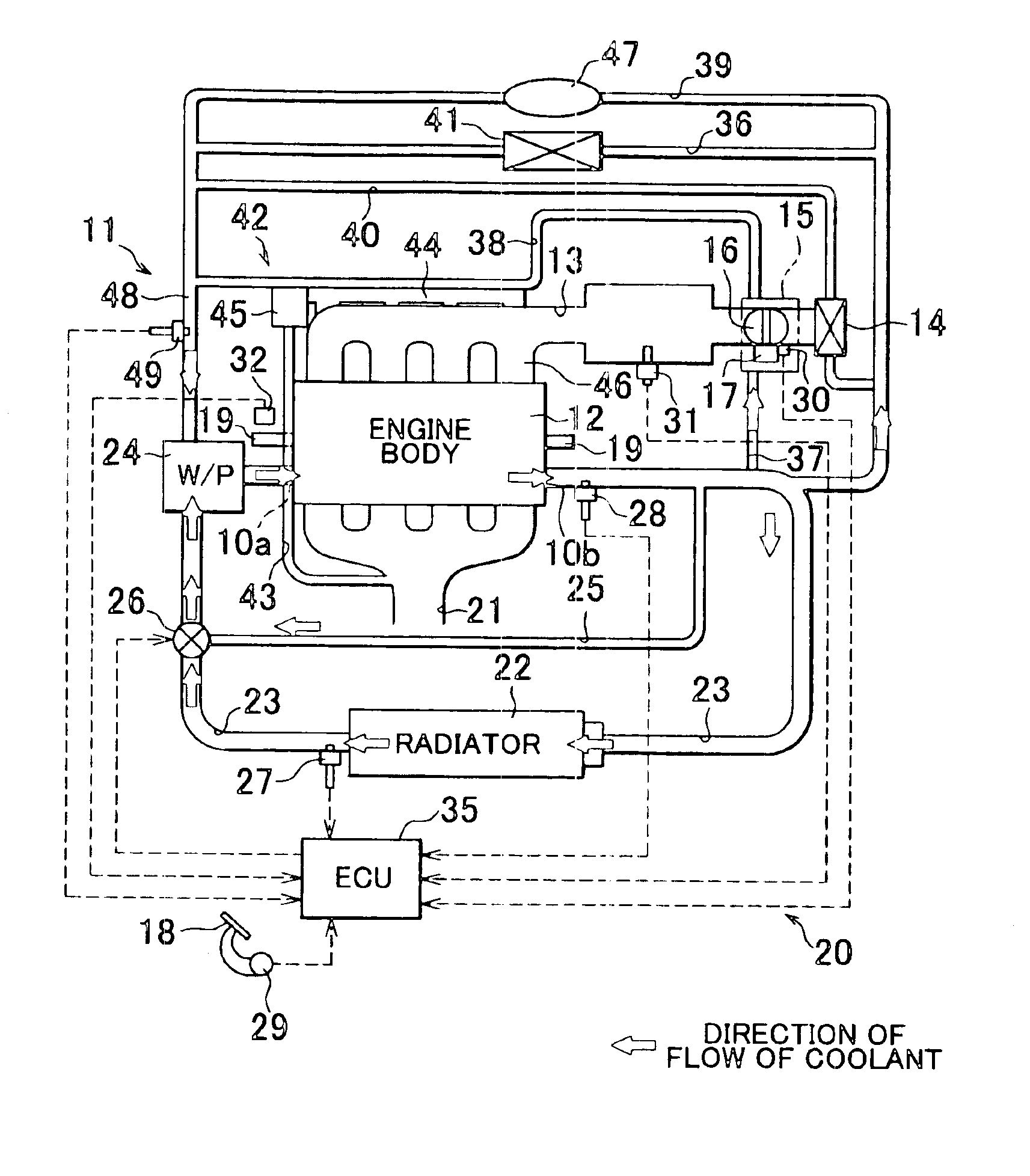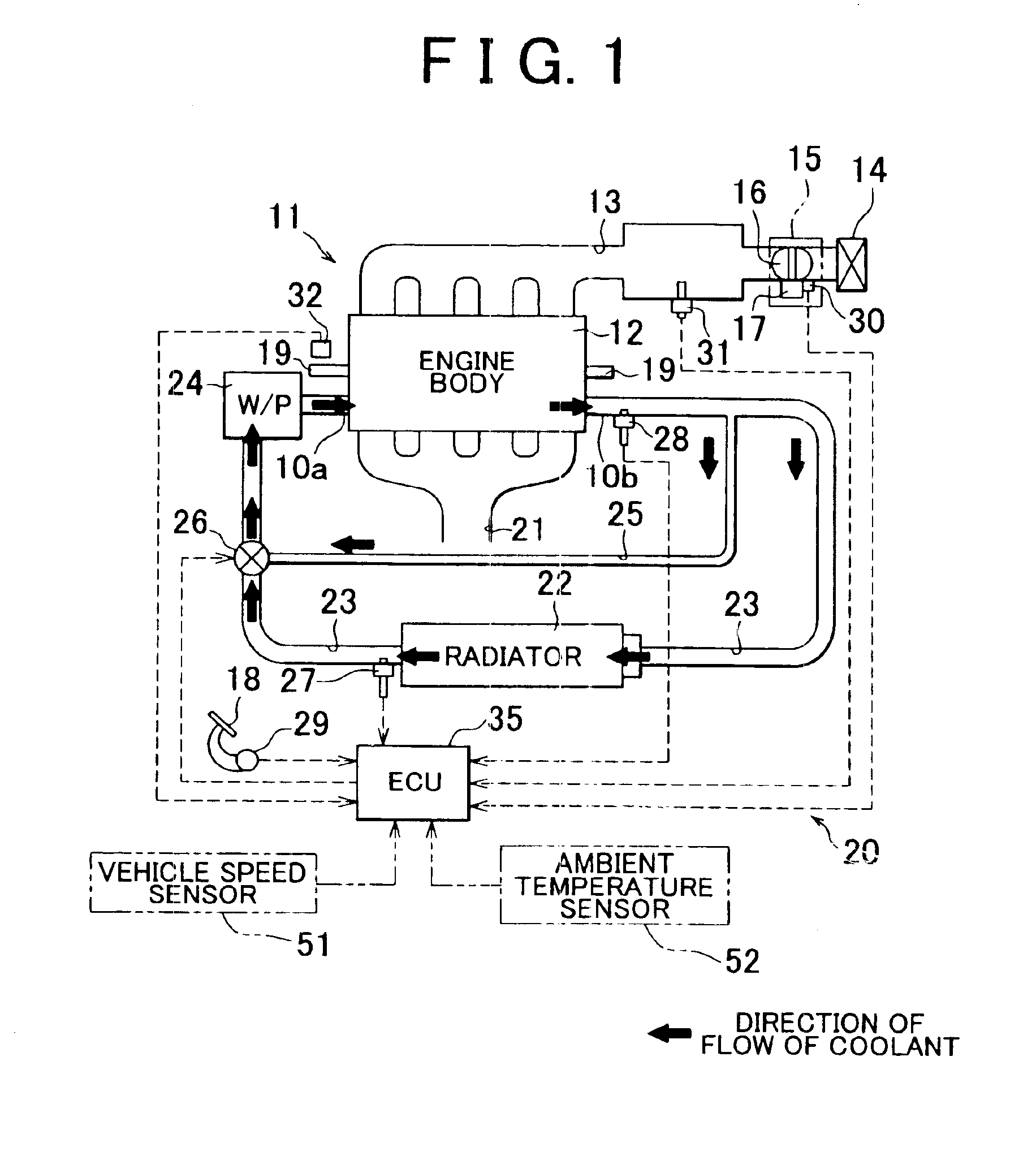Cooling system for internal combustion engine
a technology for internal combustion engines and cooling systems, applied in engine cooling apparatus, engine controllers, electric control, etc., can solve the problems of power loss, poor response of cooling systems, and inability to control the coolant temperature to the target coolant temperature, so as to improve fuel efficiency and output performance. the effect of improving the respons
- Summary
- Abstract
- Description
- Claims
- Application Information
AI Technical Summary
Benefits of technology
Problems solved by technology
Method used
Image
Examples
first embodiment
A first embodiment of the invention will be described in detail with reference to FIG. 1 through FIG. 4.
As shown in FIG. 1, a principal part of a multi-cylinder engine installed on a motor vehicle consists of an engine body 12 including a cylinder block, a cylinder head and other components. To the engine body 12 is connected an intake passage 13 through which the air is introduced into a combustion chamber of each cylinder. The intake passage 13 is provided with an air cleaner 14 and a throttle body 15. The air cleaner 14 is a filter that traps and removes dust in the air introduced into the engine body 12. A throttle valve 16 is rotatably supported in the throttle body 15, and a throttle motor 17 for driving the throttle valve 16 is operatively coupled to the throttle valve 16.
An electronic control unit (ECU) 35 controls the throttle motor 17 as described later, based on an operation of the driver to depress an accelerator pedal 18 and other parameters, so as to rotate the throttl...
second embodiment
The second embodiment as described above in detail yields the following effects in addition to the above-described effects (a) to (d).
(e) With various heat receiving / radiating circuits that bypass the radiator 22 thus provided, heat is received or radiated (in other words, incoming and outgoing radiation of heat takes place) in the process in which the coolant passes through these heat receiving / radiating circuits. The coolant which has been subjected to the incoming and outgoing radiation of heat flows into the radiator passage 23 through the water pump 24, and passes through the water jacket in the engine body 12 again. If a large quantity of heat is received or radiated in the heat receiving / radiating circuits, the engine outlet water temperature To is controlled to a target value (i.e., target engine outlet water temperature Tt) at a reduced speed with a reduced accuracy unless the received / radiated heat quantity is taken into consideration, which may result in an increased degr...
third embodiment
The third embodiment as described above in detail provides the following effects in addition to the effects (a) through (d) as described above.
(g) The cooling loss Qw of the engine body 12 is supposed to vary with the quantity of heat radiated from the engine body 12 (i.e., engine body radiated heat quantity Qoeng), in addition to the engine speed NE and the engine load. Here, the engine body radiated heat quantity Qoeng is significantly influenced by the vehicle speed SPD. Also, the engine body radiated heat quantity Qoeng is influenced by the ambient temperature THA though the degree of the influence is not so great as that of the influence by the vehicle speed SPD. If the influences of the vehicle speed SPD and the ambient temperature THA are large, the engine outlet water temperature To is slowly controlled to a target value (i.e., target engine outlet water temperature Tt) with a reduced accuracy unless the engine body radiated heat quantity Qoeng is taken into consideration, w...
PUM
 Login to View More
Login to View More Abstract
Description
Claims
Application Information
 Login to View More
Login to View More - R&D
- Intellectual Property
- Life Sciences
- Materials
- Tech Scout
- Unparalleled Data Quality
- Higher Quality Content
- 60% Fewer Hallucinations
Browse by: Latest US Patents, China's latest patents, Technical Efficacy Thesaurus, Application Domain, Technology Topic, Popular Technical Reports.
© 2025 PatSnap. All rights reserved.Legal|Privacy policy|Modern Slavery Act Transparency Statement|Sitemap|About US| Contact US: help@patsnap.com



